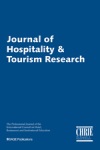
Member Login |
Using Dissatisfied Customers as a Source for Innovative Service Ideas
publication date: Sep 27, 2011
|
author/source: Philippe Duverger, Towson University
Using Dissatisfied Customers as a Source for Innovative Service Ideas
September 16, 2011 by Cynthia Nalevanko, Editor, Management INK Who is the target audience for this article? The target audience is both academics interested in service innovation and practitioners involved with brand rejuvenation and brand management in a service context. What inspired you to be interested in this topic? I spent a long time managing service operations such as hotels and restaurants before I became a researcher and an academic. During that time I was puzzled by the duality of strict standardized operating procedures allowing franchises to flourish, and the need for innovation to keep the brand fresh, penetrate other markets, and fence potential contenders. Innovation is messy, and does not go well with the smooth running of everyday service interactions or worst franchising expansion. That duality creates R&D departments working in silos disconnected from the operation and the customer. Even if marketers within the service firm do listen to customer feedback, the mantra “the customer is king” is sometime taken to mean that all customers are right. Yet, at the same time, research on customer relationship management and customer lifetime value tends to tell us that some customers are more valuable than others. Some even advocate “firing your worst customers”. I ask myself “what if the most dissatisfied customer holds the key to the next innovation?” Were there findings that were surprising to you? I was surprised that defectors, customers that decided after long disappointing service encounters to patronize other providers, would be willing to participate in a creativity exercise with the service provider they defected from. Even more surprised that the ideas given, more likely stemming from their unmet needs, where well received by the same executives that would have more likely disregarded their complaints before. How do you see this study influencing future research and/or practice? I wish service companies will recognize the need to have a different conversation with dissatisfied customers than they have currently. Service providers need to listen differently to the most dissatisfied customers in order to capture innovative ideas. From a research stand point there is much to be done in the service area with respect to innovation research. Particularly with the advent of the Internet and the user-generated content (customer postings and the like) that might be harvested and leveraged by the firm in search of the next big service idea. How does this study fit into your body of work/line of research? I love services for their complexity in dealing with processes that have one chance to be perfect, and I want to help by continuing the stream of research that focuses on service innovation leveraging all possible angles of research including Internet-based idea generation, innovative idea implementation, and innovation diffusion to give a few examples. How did your paper change during the review process? The editor and reviewers were a great help in the focus of the paper, as well as forcing me to clarify certain concepts or data descriptions that helped make a paper than I am proud of. What, if anything, would you do differently if you could go back and do this study again? I would more likely capture more information about the customers in an attempt to explain their innovative behaviors and results with underlying personality traits. |
Search the SiteEducator Profiles |
